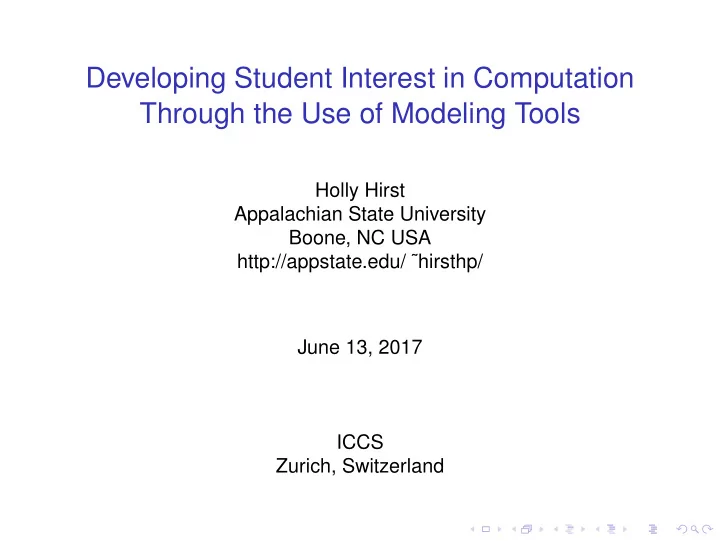

Developing Student Interest in Computation Through the Use of Modeling Tools Holly Hirst Appalachian State University Boone, NC USA http://appstate.edu/ ˜hirsthp/ June 13, 2017 ICCS Zurich, Switzerland
Rationale ◮ Over the past decade, a variety of free computational modeling tools have become available for use in secondary and college courses. ◮ These tools provide an excellent introduction to computation for students who have yet to develop skill at or interest in creating or modifying code. ◮ My experience with prospective teachers, math majors, and university faculty: Once exposed to these tools through modeling projects, students have reported that they understand the value of computation in solving problems, and also the limitations of the tools – which highlights the need to delve further into computational techniques.
insightmaker.com A free, web-based tool for systems modeling. Others: Simulink; VensimPLE; Stella; Simile; Berkeley Madonna. Example: Let R represent the number of rabbits grazing on asparagus, the amount of which is represented by A . 1. Rabbit births: ∝ R and ∝ A imply: = rabbit b × A × R . 2. Rabbit deaths: ∝ R implies: = rabbit d × R . 3. Asparagus growth: constant a growth . 4. Asparagus grazing: ∝ R and ∝ A imply: = a graze × R × A 5. The other important model factor is Time: unit=weeks; duration=0..6; time step = 2 ? 3 to simulate frequent eating.
insightmaker.com - 2 Click and drag to build the model from stocks, flows, links, and variables, and then enter the mathematics into each component.
insightmaker.com - 3 Starting with 10 acres of asparagus and 2 rabbits, and setting all the factors to 0.1.
modelling4all.org A free, web-based tool for agent modeling that allows students to get started with NetLogo through a “click and drag,” non-coding interface. Others: agentsheets.com; agentcubesonline.com; ccl.northwestern.edu/netlogo/. Example: Suppose we want to model having two predators find prey and eat them. We could start with the following assumptions: ◮ There are 20 prey individuals moving around at random. ◮ There are 2 predator individuals moving around at random. ◮ When a predator individual encounters prey, the predator eats the prey individual with a probability of .7
modelling4all.org - 2 First we create prototypes for our prey, predator, the world and the observer, giving each a list of behaviors. Each behavior can be enhanced, for example to repeat and/or to occur with some probability. Behaviors are “click and drag” – a large list of common behaviors, such as “forward repeatedly” are given in the library that can be customized and then added to the appropriate prototype.
modelling4all.org - 3 We end up with an interface that runs in the browser, and is download-able as a Netlogo 6 file.
gephi.org A free software tool for exploring graphs and networks. Others: socnetv.org; netlytic.org; nodeXL.codeplex.com (excel addin); statnetproject.org (R addin). Example: Predicting what will happen in a company when the question of unionization is brought forward to employees. ◮ Given: Friendship ties among the 36 employees, and results of a survey asking how employees felt about joining a union. Most (26) indicated that they had no opinion. Persons 4, 13, 16, 18, and 19 opposed unionizing. Persons 8, 9, 10, 15, and 29 were in favor. ◮ Goal: Analyze these data to determine a few employees that the company management can work with to help undecided employees understand the reasons to NOT unionize. ◮ Assumption: Those with no opinion will likely be persuaded by their friends.
gephi.org - 2 1. Organize friendship ties in a spreadsheet, with each row consisting of one employee in column A and all friends in subsequent columns. Import into gephi. 2. Run graph layouts to find a good visualization of the graph. (Fruchterman Reingold is suggested.) 3. Calculate measures of center ◮ “degree” – number of edges ◮ “betweenness” – number of shortest paths through a node ◮ “closeness” – the node that is closest on average to all the other nodes 4. Use the measures of center to determine who among the people in favor of the unions and who among the undecided could be approached.
gephi.org - 3 Graphs before and after running layout process Students can quickly see the results of the different measures of center and draw conclusions.
Getting these slides, some videos, and some examples go to my website and find the link for “recent talks” in the left sidebar http://appstate.edu/ ˜hirsthp/ direct link http://appstate.edu/ ˜hirsthp/talks/iccs2017/index.html
Recommend
More recommend